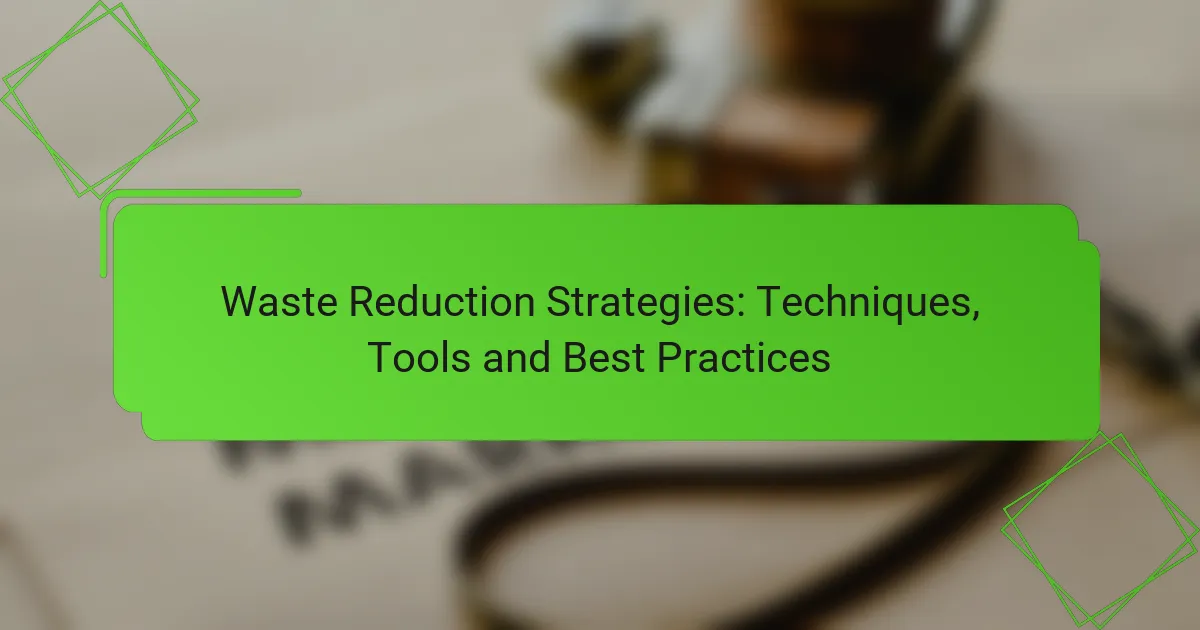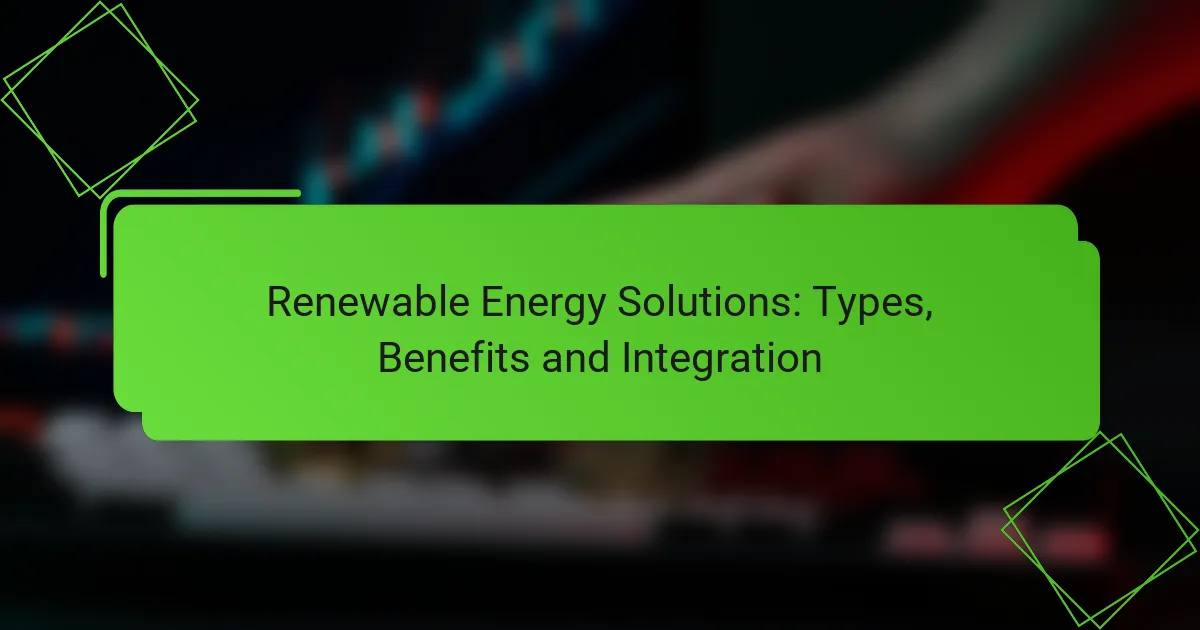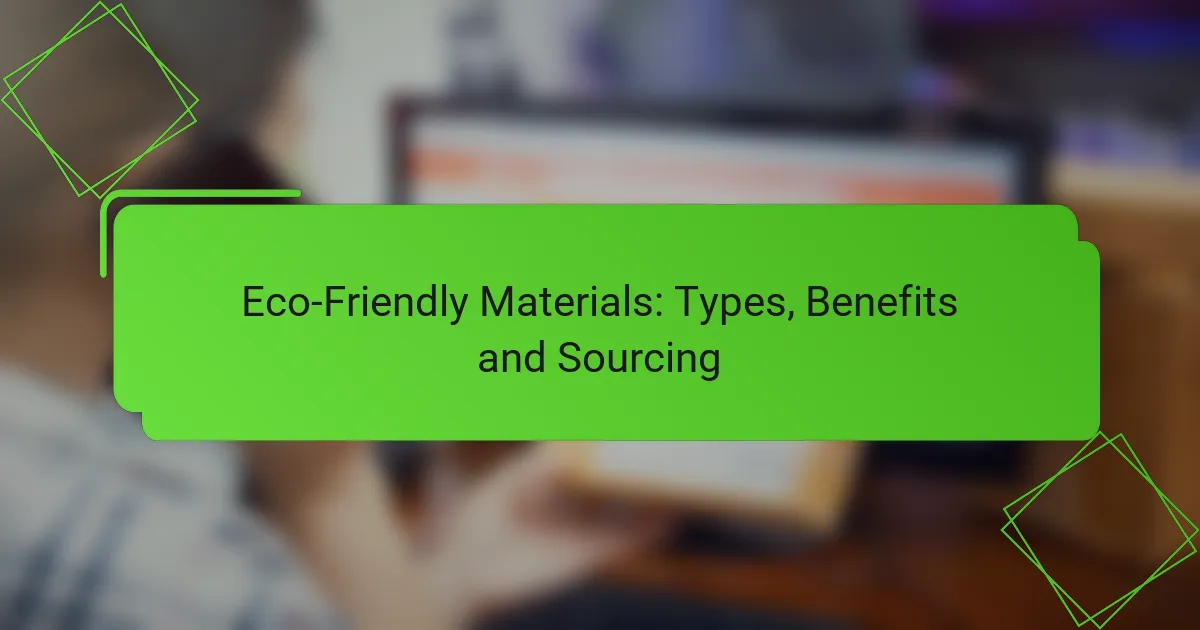Waste reduction strategies are essential for promoting sustainability and resource efficiency. By implementing techniques such as composting, recycling, and reducing single-use plastics, individuals and businesses can significantly minimize waste generation. Utilizing various tools for waste tracking and management further enhances these efforts, allowing for better monitoring and improved operational efficiency.
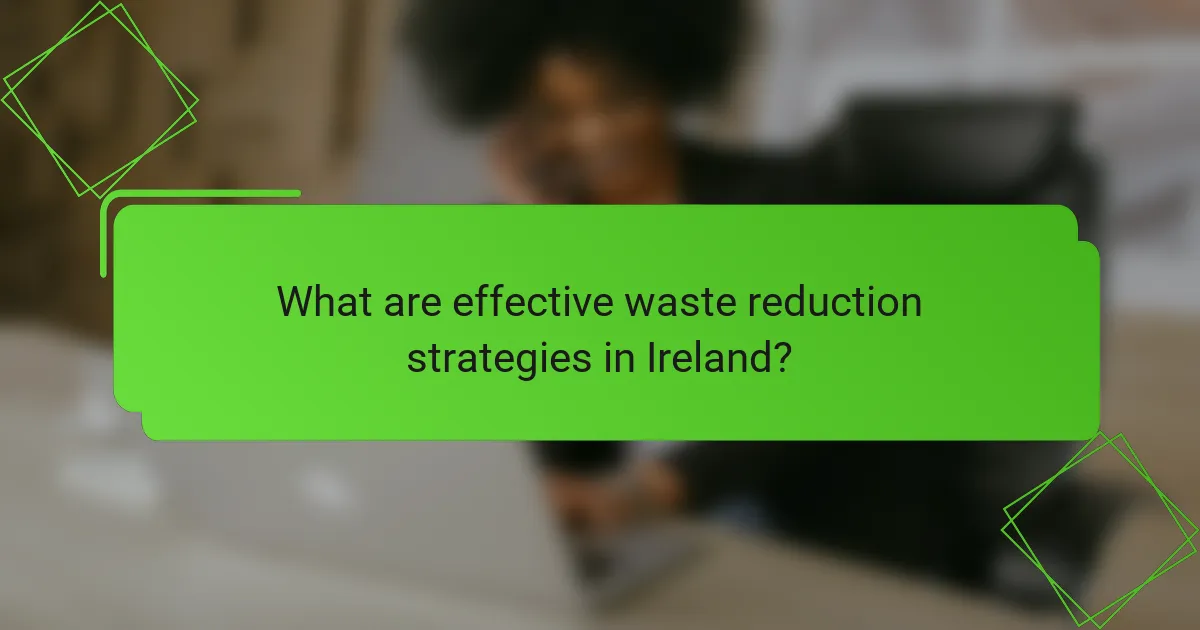
What are effective waste reduction strategies in Ireland?
Effective waste reduction strategies in Ireland include practices that minimize waste generation and promote resource efficiency. Key approaches involve composting, recycling, reducing single-use plastics, encouraging bulk purchases, and adopting circular economy principles.
Composting organic waste
Composting organic waste involves collecting biodegradable materials such as food scraps and garden waste to create nutrient-rich compost. This process not only reduces landfill waste but also enriches soil, promoting healthier plants.
To start composting, consider using a compost bin or pile in your garden. Ensure a balance of green materials (like fruit peels) and brown materials (like dry leaves) to facilitate decomposition. Aim for a composting temperature of around 55-65°C for optimal breakdown.
Implementing recycling programs
Recycling programs are essential for diverting waste from landfills and conserving resources. In Ireland, local authorities often provide recycling bins for paper, plastics, and metals, making it easier for residents to participate.
To effectively recycle, familiarize yourself with local guidelines regarding what can and cannot be recycled. Clean and dry recyclables, and avoid wish-cycling—placing non-recyclables in recycling bins with the hope they will be processed.
Reducing single-use plastics
Reducing single-use plastics is a crucial strategy for waste reduction in Ireland. This includes minimizing the use of plastic bags, straws, and cutlery, which contribute significantly to environmental pollution.
Consider alternatives such as reusable bags, stainless steel straws, and biodegradable utensils. Many retailers in Ireland now offer incentives for customers who bring their own containers, further encouraging this shift.
Encouraging bulk purchasing
Encouraging bulk purchasing helps reduce packaging waste and can lead to cost savings. Buying in larger quantities often results in less waste generated from individual packaging.
Look for local stores that offer bulk bins for grains, nuts, and other staples. Bring your own containers to fill, which not only cuts down on waste but also supports local businesses.
Adopting circular economy principles
Adopting circular economy principles focuses on designing products and systems that minimize waste and make the most of resources. This approach emphasizes reusing, repairing, and recycling materials to create a sustainable cycle.
Businesses and consumers can contribute by choosing products designed for longevity and recyclability. Engaging in community initiatives that promote repair workshops or second-hand exchanges can also foster a circular mindset.
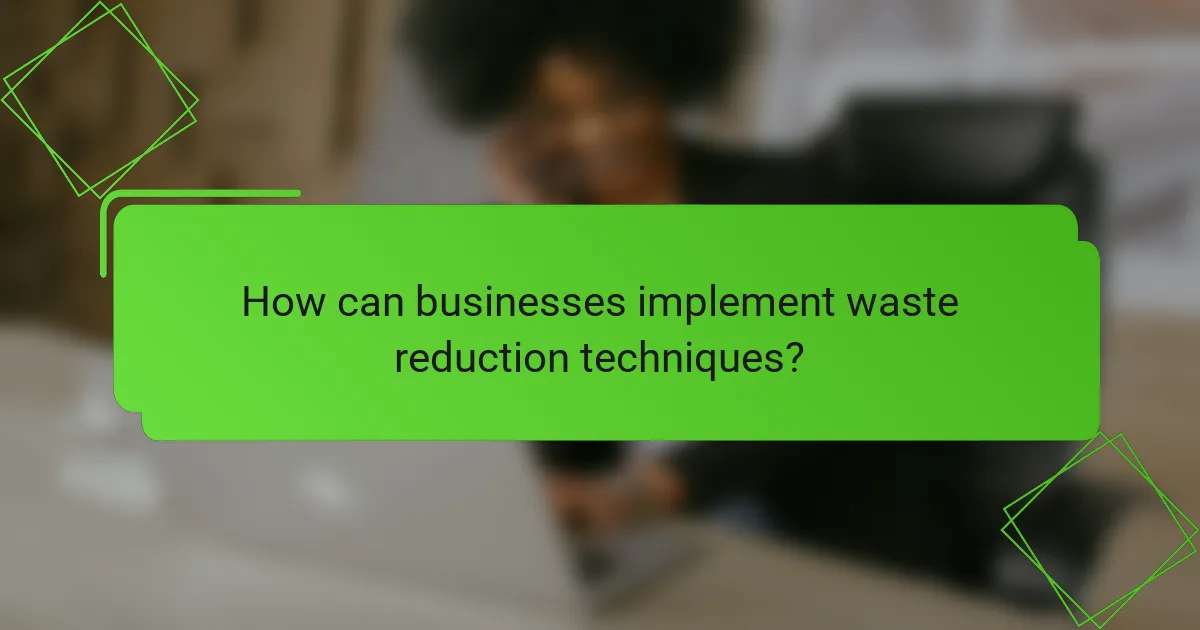
How can businesses implement waste reduction techniques?
Businesses can implement waste reduction techniques by assessing their current waste output, educating staff, and establishing clear goals. These strategies not only minimize waste but also enhance operational efficiency and reduce costs.
Conducting waste audits
Conducting waste audits helps businesses identify the types and quantities of waste they generate. This process involves analyzing waste streams to pinpoint areas for improvement, such as reducing excess packaging or optimizing resource use.
To perform a waste audit, collect samples of waste over a specific period, categorize them, and measure their volume. This data allows companies to prioritize waste reduction efforts based on the most significant waste sources.
Training employees on waste management
Training employees on waste management is crucial for fostering a culture of sustainability within a business. Employees should understand the importance of waste reduction and be equipped with practical skills to minimize waste in their daily tasks.
Effective training programs can include workshops, informational sessions, and hands-on activities. Encourage employees to share their ideas for waste reduction and recognize their contributions to motivate ongoing engagement.
Setting measurable waste reduction goals
Setting measurable waste reduction goals provides a clear target for businesses to aim for. These goals should be specific, achievable, and time-bound, allowing companies to track their progress over time.
For example, a business might aim to reduce waste by 20% within a year or to recycle 50% of its total waste. Regularly reviewing these goals and adjusting strategies as necessary can help maintain momentum and drive continuous improvement.
![]()
What tools are available for waste tracking and management?
Various tools exist for effective waste tracking and management, including software solutions, mobile applications, and data analytics platforms. These tools help organizations monitor waste generation, streamline disposal processes, and enhance recycling efforts.
Waste management software
Waste management software provides comprehensive solutions for tracking waste production and disposal. These platforms often include features for scheduling pickups, managing inventory, and generating reports on waste streams.
When selecting waste management software, consider factors such as user-friendliness, integration capabilities with existing systems, and compliance with local regulations. Popular options include WasteLogics and Envirosite, which cater to different organizational needs.
Mobile apps for tracking waste
Mobile apps for tracking waste allow users to monitor waste generation in real-time, making it easier to identify trends and areas for improvement. These apps often include features for scanning barcodes, logging waste types, and setting reminders for disposal.
Examples of effective mobile apps include MyWaste and WasteWise, which provide intuitive interfaces for users to track their waste habits. Ensure the app you choose aligns with your specific waste management goals and offers relevant features.
Data analytics platforms
Data analytics platforms analyze waste data to provide insights into generation patterns and disposal efficiency. These tools can help organizations identify opportunities for waste reduction and optimize their recycling programs.
When using data analytics for waste management, focus on platforms that offer customizable dashboards and reporting capabilities. Solutions like Tableau and Microsoft Power BI can help visualize waste data and support decision-making processes.
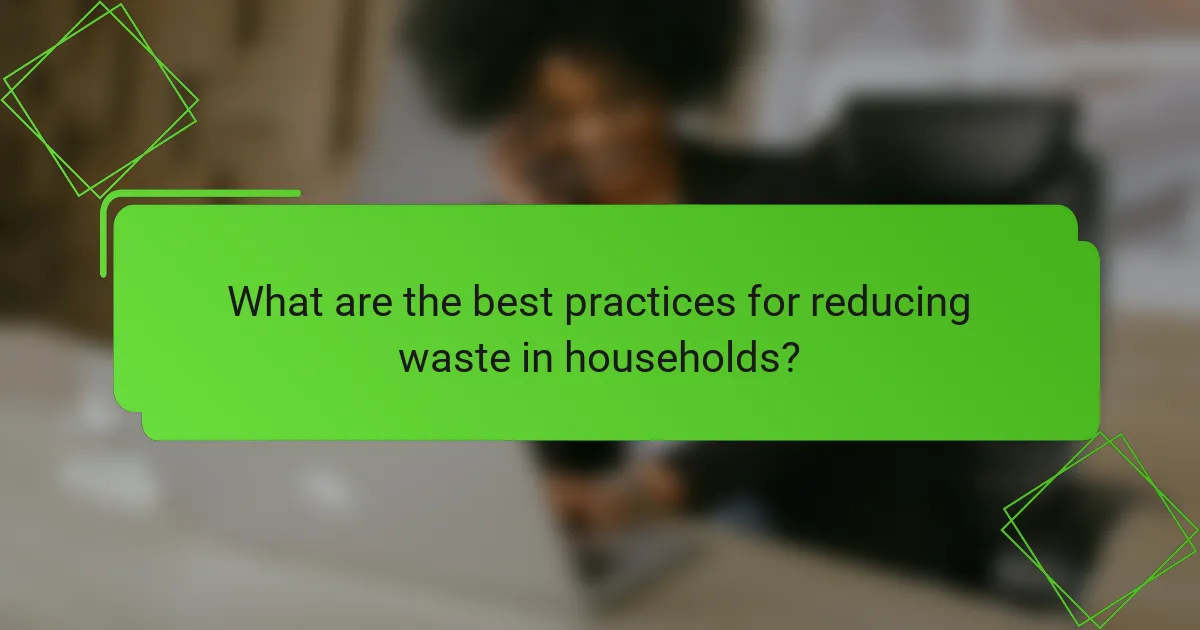
What are the best practices for reducing waste in households?
To effectively reduce waste in households, implement strategies that focus on reusability, mindful consumption, and community engagement. These practices not only minimize the amount of waste generated but also promote sustainable living and resource conservation.
Using reusable containers
Using reusable containers is a straightforward way to cut down on single-use plastics and other disposable items. Opt for glass, stainless steel, or BPA-free plastic containers for storing food, drinks, and leftovers. This not only reduces waste but can also save money over time.
When purchasing reusable containers, consider their size and versatility. A variety of sizes can accommodate different types of food and portions, making it easier to avoid excess packaging. Regularly check for wear and tear to ensure they remain safe and effective.
Minimizing food waste
Minimizing food waste involves planning meals, proper storage, and using leftovers creatively. Start by creating a shopping list based on your meal plan to avoid buying unnecessary items. Store food correctly to extend its shelf life, and be mindful of expiration dates.
Utilize leftovers by incorporating them into new dishes or freezing them for later use. Composting organic waste is another effective way to reduce food waste while enriching soil for gardening. Aim to reduce food waste by at least 30% through these practices.
Participating in local swap events
Participating in local swap events allows households to exchange items they no longer need, reducing waste and promoting community engagement. These events can include clothing swaps, book exchanges, or general item trades, helping to keep usable goods out of landfills.
Check community boards or social media for upcoming swap events in your area. Bring items in good condition and be open to taking home something new. This practice not only reduces waste but also fosters connections with neighbors and supports a circular economy.

What role does legislation play in waste reduction?
Legislation is crucial for waste reduction as it establishes frameworks and standards that guide businesses and individuals in minimizing waste. Effective laws can incentivize sustainable practices, promote recycling, and hold producers accountable for their products’ lifecycle.
Extended Producer Responsibility (EPR) laws
Extended Producer Responsibility (EPR) laws require manufacturers to take responsibility for the entire lifecycle of their products, including post-consumer waste management. This approach encourages companies to design products that are easier to recycle or dispose of, ultimately reducing waste.
Under EPR, producers may be required to fund recycling programs or manage the disposal of their products after consumer use. This can lead to significant reductions in landfill waste and promote the circular economy, where materials are reused rather than discarded.
For example, in the European Union, EPR laws have been implemented for packaging, electronics, and batteries, compelling manufacturers to create take-back schemes. Companies should assess their compliance with local EPR regulations and consider how to integrate sustainable practices into their product design.
